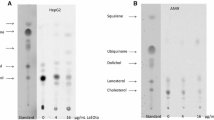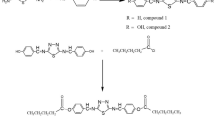Abstract
A series of 2-benzoyl-4,4-dialkyl-3,5-isoxazolidinediones proved to have potent hypolipidemic activity, lowering both serum cholesterol and triglyceride levels at 10 or 20 mg/kg/day, IP and orally in rodents. 2-(3,4,5-Trimethoxybenzoyl)-4,4-diethyl-3,5-isoxazolidinedione (4) afforded the best hypolipidemic activity lowering normolipidemic CFl mouse serum cholesterol levels 49% and serum triglyceride levels 34% at 20 mg/kg/day, IP. Compound 4 was selected as a typical derivative of the chemical class for further detailed studies. Serum cholesterol levels in normolipidemic Sprague Dawley male rats were reduced 45% after 8 weeks at 10 and 20 mg/kg/day of compound, orally. Serum triglyceride levels were reduced 38–49% at 10 and 20 mg/kg/day, orally. In vitro liver enzyme activities studies in normolipidemic CFl mice showed the compound inhibited mitochondrial citrate exchange, acetyl CoA synthetase, HMG CoA reductase, acyl CoA cholesterol acyl transferase, acetyl CoA carboxylase, sn-glycerol-3-phosphate acyl transferase, phosphatidylate phosphohydrolase and heparin-induced lipoprotein lipase activities with increases in the activities of cholesterol ester hydrolase and ATP-dependent citrate lyase. Similar enzyme activities were inhibited in vivo except HMG CoA reductase activity was not inhibited in rat liver or small intestinal mucosa after 8 weeks drug administration. Cholesterol levels were reduced in tissues after 8 weeks administration of compound 4 in normolipidemic rats. Bile cholesterol and triglyceride levels were elevated after two weeks administration to rats at 20 mg/kg/day. Serum lipoprotein levels in normolipidemic and hyperlipidemic rats showed the cholesterol levels in VLDL and LDL fractions after 4, 6 and 8 weeks at 10 and 20 mg/kg/day were reduced whereas HDL-cholesterol levels were significantly elevated. Studies demonstrated that 3H-cholesterol and 14C-palmitic acid incorporation into lipids of the lipoprotein fraction was reduced by the drug but 32P-incorporation was generally elevated. The agent demonstrated no observable toxicity in rats after 8 weeks administration, orally. The acute toxicity study in normolipidemic mice at 20, 40 and 100 mg/ kg/day, IP, demonstrated no observable harmful effects of the drug.
Similar content being viewed by others
REFERENCES
J.M. Chapman, Jr., J.W. Sowell, Sr., G. Abdalla, I.H. Hall, and O.T. Wong. Hypolipidemic activity of cyclic imido alky ethers, thioethers, sulfoxide and sulfones. J. Pharm. Sci. 78, 903–909, 1989.
I.H. Hall, J.M. Maguire, O.T. Wong, P.A. Day, and R.S. Alphin. Comparison of the S(+) and R(−) enantiomers of 5-ethyl-5-phenylhydantoin as hypolipidemic agents in rodents. Biomed. Biochim. Acta 46, 623–634, 1987.
I.H. Hall, M.A. Patrick, and J.H. Maguire. Hypolipidemic activity in rodents of phenobarbital and related derivatives. Archiv Pharm. 323, 579–586, 1990.
I.H. Hall, J.M. Chapman, Jr., and C. Gilbert. The hypolipidemic activity of benzenetricarboxylic acids in rodents. Pharm. Res. 1, 63–68, 1984.
G.H. Cocolas, J.M. Chapman, Jr., and I.H. Hall. Hypolipidemic activity of substituted 2-pyrrolidenones in rodents. J. Pharm. Sci. 72, 812–814, 1983.
I.H. Hall, G.H. Cocolas, and P.J. Voorstad. Hypolipidemic activity of 4 phenyl-5-dicarbethoxy-2-pyrrolidinone in rodents. J. Pharm. Sci. 73, 812–815, 1984.
I.H. Hall, G.H. Cocolas, and W.L. Williams, Jr. Hypolipidemic activity of 4-pyrimidine carboxylic acids in CF1 mice. J. Pharm. Sci. 73, 1819–1820, 1984.
I.H. Hall, W.L. Williams, Jr., K.A. Rhyne, and M. Knowles. The hypolipidemic activity of furoic acid and furylacrylic acid derivatives in rodents. Pharm. Res. 2, 233–238, 1985.
A.R.K. Murthy, J.M Maguire, R.S. Alphin, P.A. Day, and I.H. Hall. Hypolipidemic activity of a series of 3 and 4-phenylpiperidine-2,6-diones and selected N-substituted derivatives. Lipids 21, 617–622, 1986.
G. Zinner, H. Ruthe, and D. Bose. Synthesen in der Reihe der Isoxazolidin-3,5-dione. Teil 2, 37, mitteilung: Uber Hydroxylaminderivate. Pharmazie 29, 16–20, 1974.
G. Zinner, and R. Moll. Synthesen in der Reihe der 3,5,-Dioxoisoxazolidine. Archiv Pharm. 299, 562–568, 1966.
K. Rehse, and J. Meder. Anticoagulante Isoxazolidin-3,5-dione. Archiv Pharm. 319, 133–140, 1986.
R.A. Izydore, and I.H. Hall. Hypolipidemic activity of isoxazolidine-3,5-diones. Abstract Med: 126, joint meeting of 3rd Chemical Congress of North America and 195th American Chemical Society National Meeting, 1988, Toronto, Ontario, Canada.
A.C. Konaji, and B.D. Hosangadi B.D. Synthesis of hydroxamic acids using dicyclohexylcarbodiimide and cation exchange chromatography. Indian J. Chem. 17B, 275–276, 1979.
R.A. Izydore, M.L. Debnath, T. Woodard, O.T. Wong, and I.H. Hall. Hypolipidemic activity of benzohydroxamic acids and dibenzohydroxamic acids in rodents. Res. Comm. Chem. Path. Pharmacol. 70, 307–321, 1990.
R. Simlot, R.A. Izydore, O.T. Wong, and I.H. Hall. Synthesis and hypolipidemic activity of 4-substituted 1-acyl-1,2,4-triazolidine-3,5-diones in rodents. J. Pharm. Sci. 82, 408–415, 1993.
R. Simlot, R.A. Izydore, O.T. Wong and I.H. Hall. Hypolipidemic activity of 4-substituted 1,2-diacyl-1,2,4-triazolidine-3,5-diones in rodents. J. Pharm. Sci. 83, 367–371, 1994.
I.H. Hall, R. Simlot, P. Day, O.T. Wong, H. ElSourady, and R.A. Izydore. The hypolipidemic effects of 1-acetyl-4-phenyl-1,2,4-triazolidine-3,5-dione in rodents. Pharm. Res. 10, 1206–1211, 1993.
B.A. Brown. Hematology Principles and Procedures. 4th edition, Lea and Febinger, Philadelphia, 29–72, 1984.
G. Zinner, R. Moll, B. Bohlke, R.O. Weber, and W. Deucker. Aminomethylierung 5-ringgliedriger hydrazide and hydroxylamide. Archiv Pharm. 299, 222–225, 1966.
I.H. Hall, O.T. Wong, R. Simmlot, and R.A. Izydore. Effects of isoazolidine or triazolidine on rat serum lipids in vivo and LDL and HDL binding and degradation in human and rodent cultured cell in vitro. Res. Comm. Chem. Path. Pharm. 77, 327–346, 1992.
I.H. Hall, O..T. Wong, and S.D. Wyrick. The effects of phthalimide and saccharin derivatives on the LDH and HDL receptor activity and related enzyme activities. Pharm. Res. 5, 413–420, 1988.
I.H. Hall, B.F. Spielvogel, T.S. Griffin, E.L. Docks, and R.J. Brotherton. The effects of boron hypolipidemic agents on LDL and HDL receptor building and related enzyme activities of rat hepatocytes, aorta cells and human fibroblasts. Res. Comm. Chem. Path. & Pharm. 65, 297–317, 1989.
I.H. Hall, O.T. Wong, D.J. Reynolds, and C.B. Oswald. Effects of 2,3-dihydrophthalazine-1,4-dione on Sprague Dawley rats lipid metabolism and serum lipoproteins. Biomed. Biochim. Acta 47, 423–433, 1988.
T.A. Miettinen, J.K. Huttunen, T. Strandberg, V. Naukkarinen, S. Mattila, and T. Kumlin. Lowering HDL cholesterol and incidence of ischaemic heart disease. Lancet 4, 478, 1981.
Author information
Authors and Affiliations
Rights and permissions
About this article
Cite this article
Woodard, T., Debnath, M.L., Simlot, R. et al. Investigation of 3,5-Isoxazolidinediones as Hypolipidemic Agents in Rodents. Pharm Res 12, 24–38 (1995). https://doi.org/10.1023/A:1016226317975
Issue Date:
DOI: https://doi.org/10.1023/A:1016226317975




